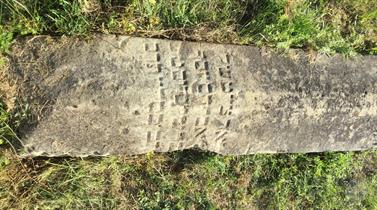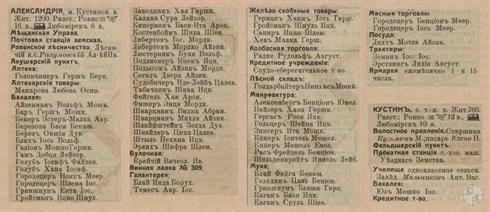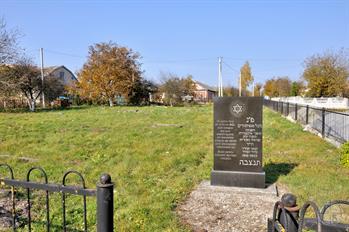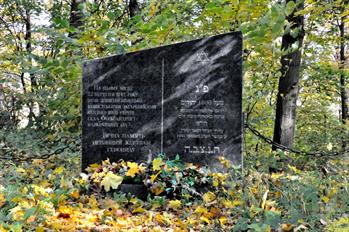Oleksandriya
Rivne district, Rivne region
Sources:
- The All South-Western Territory: reference and address book of the Kyiv, Podolsk and Volyn provinces. Printing house L.M. Fish and P.E. Wolfson, 1913;
- Yad Vashem. Aleksandria;
- A.I. Kruglov, "Oleksandriya", [in:] I.A. Altman (ed.), Holokost na tieritorii SSSR, Moscow 2009
Photo:
- European Jewish Cemeteries Initiative. Oleksandriya Jewish Cemetery;
- Serhiy LS, Wikipedia. Oleksandriya (holocaust memorials)
- The All South-Western Territory: reference and address book of the Kyiv, Podolsk and Volyn provinces. Printing house L.M. Fish and P.E. Wolfson, 1913;
- Yad Vashem. Aleksandria;
- A.I. Kruglov, "Oleksandriya", [in:] I.A. Altman (ed.), Holokost na tieritorii SSSR, Moscow 2009
Photo:
- European Jewish Cemeteries Initiative. Oleksandriya Jewish Cemetery;
- Serhiy LS, Wikipedia. Oleksandriya (holocaust memorials)
Oleksandriya (ukr. Олександрія, rus. Александрия) was founded in 1518 in Volyn Voivodeship as part of the Commonwealth. Since 1793 - as part of the Russian Empire. In the 19th - early 20th centuries - the township of Kustin volost (sub-district) of Rivne district of the Volyn province. In 1919–39 - in the Volyn Voivodeship as part of Poland, in 1939–91 - as part of the Ukrainian SSR.
In 1897, 2154 Jews lived in Oleksandriya (67,5%),
in 1921 - 1293 Jews (73%),
in 1939 - approx. 1500 Jews.
In 1913, Jews owned only wood warehouse and all 58 shops (excluding only 1 shop, where non-Jews traded non-kosher meat).
The Jew Yosef Zerman owned 1 of 2 taverns, Hersh Holovchiner owned only farmacy.
In the center of sub-district, village of Kustin, there was only 1 shop, wich belonged to Jew Moshko (Moses) Yuz.
After World War I Oleksandriya was incorporated into the independent Polish State.
Zionist parties and its youth organizations (HaShomer Hatzair, Beitar, Gordonia and HeHalutz Hatzair) were active in the town. Oleksandriya had a Tarbut Zionist Hebrew-language school.
In 1897, 2154 Jews lived in Oleksandriya (67,5%),
in 1921 - 1293 Jews (73%),
in 1939 - approx. 1500 Jews.
In 1913, Jews owned only wood warehouse and all 58 shops (excluding only 1 shop, where non-Jews traded non-kosher meat).
The Jew Yosef Zerman owned 1 of 2 taverns, Hersh Holovchiner owned only farmacy.
In the center of sub-district, village of Kustin, there was only 1 shop, wich belonged to Jew Moshko (Moses) Yuz.
After World War I Oleksandriya was incorporated into the independent Polish State.
Zionist parties and its youth organizations (HaShomer Hatzair, Beitar, Gordonia and HeHalutz Hatzair) were active in the town. Oleksandriya had a Tarbut Zionist Hebrew-language school.
After the German invasion to the USSR on June 22, 1941, some Jews were able to evacuate to the east, leaving more than 1,000 Jews at the start of the German occupation.
Germans captured Oleksandriya on July 1, 1941. On July 1-4, Ukrainian nationalists carried out anti-Jewish pogroms, including the burning of synagogues and plundering of the Jewish homes. They also murdered several Jews. On July 31, 85 Jews, mainly males, along with some pro-Soviet activists were killed by SD unit on the bank of the Horyn River.
In the summer and fall of 1941, the German occupying forces implemented a number of discriminatory measures against the Jews in Oleksandriya: a Jewish council (Judenrat) headed by Avigdor Grushka with nine members was appointed. Jews were ordered to wear distinguishing marks (initially the Star of David, then later a yellow circle). They were assigned to perform hard labor, sometimes without pay; and they were forbidden to leave the confines of the town. They also had to pay a high ransom to German authorities.
Apparently in late August 1942 Germans ordered all the local Jews (about 1,000 people) to be concentrated in a ghetto, which was established on a side street and surrounded by a fence and barbed wire along the banks of the Horyn River.
The ghetto was liquidated on September 23, 1942 when 903 people were killed by German units assisted by Ukrainian auxiliary police in the nearby Svyattya Forest.
Several dozens Jews managed to flee on the eve of the ghetto's liquidation and were hiding in the town and its surroundings. Some of them were caught in the subsequent days and killed at the bank of Horyn River. Others 85 Jews were lured by Karl Heifler, a landwirt (agricultural leader) of Aleksandria and returned to the town. On October 28, 1942 they all were captured and shot by a German unit at the Jewish cemetery of Oleksandriya.
Germans captured Oleksandriya on July 1, 1941. On July 1-4, Ukrainian nationalists carried out anti-Jewish pogroms, including the burning of synagogues and plundering of the Jewish homes. They also murdered several Jews. On July 31, 85 Jews, mainly males, along with some pro-Soviet activists were killed by SD unit on the bank of the Horyn River.
In the summer and fall of 1941, the German occupying forces implemented a number of discriminatory measures against the Jews in Oleksandriya: a Jewish council (Judenrat) headed by Avigdor Grushka with nine members was appointed. Jews were ordered to wear distinguishing marks (initially the Star of David, then later a yellow circle). They were assigned to perform hard labor, sometimes without pay; and they were forbidden to leave the confines of the town. They also had to pay a high ransom to German authorities.
Apparently in late August 1942 Germans ordered all the local Jews (about 1,000 people) to be concentrated in a ghetto, which was established on a side street and surrounded by a fence and barbed wire along the banks of the Horyn River.
The ghetto was liquidated on September 23, 1942 when 903 people were killed by German units assisted by Ukrainian auxiliary police in the nearby Svyattya Forest.
Several dozens Jews managed to flee on the eve of the ghetto's liquidation and were hiding in the town and its surroundings. Some of them were caught in the subsequent days and killed at the bank of Horyn River. Others 85 Jews were lured by Karl Heifler, a landwirt (agricultural leader) of Aleksandria and returned to the town. On October 28, 1942 they all were captured and shot by a German unit at the Jewish cemetery of Oleksandriya.

- Home
- Shtetls
- Vinnytsia region
- Volyn region
- Dnipro region
- Donetsk region
- Zhytomyr region
- Zakarpattia region
- Zaporizhzhia region
- Ivano-Frankivsk region
- Kyiv region
- Kropyvnytskyi region
- Luhansk region
- Lviv region
- Mykolayiv region
- Odessa region
- Poltava region
- Rivne region
- Sumy region
- Ternopil region
- Kharkiv region
- Kherson region
- Khmelnytskyi region
- Chernihiv region
- Chernivtsi region
- Cherkasy region
- Crimea
- Synagogues
- Cemeteries
- Objects & guides
- Old photos
- History
- Contact
Jewish towns of Ukraine
My shtetl
My shtetl
Donate
Jewish towns of Ukraine




